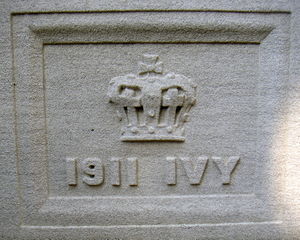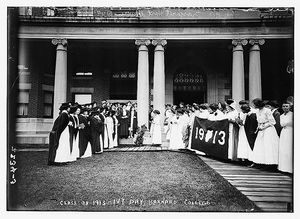Difference between revisions of "Class Ivy"
Absentminded (talk | contribs) |
|||
| (3 intermediate revisions by one other user not shown) | |||
| Line 1: | Line 1: | ||
| − | The planting of '''Class Ivy''' by graduating seniors is a tradition at many colleges. While no such tradition | + | The planting of '''Class Ivy''' by graduating seniors is a tradition at many colleges. While there is no such tradition extant at Columbia, planting ceremonies did occur on the [[Midtown campus]], and there are indications that a tradition of class plantings briefly sprouted on the [[Morningside Heights campus]] during the first decade of the 20th century. In addition, [[Barnard College]] had its own tradition of 'Ivy Days.' |
== Class Ivy at Columbia == | == Class Ivy at Columbia == | ||
[[Image:1911ivycrown.jpg|thumb|right|Tablet on [[Hamilton Hall]] marking the 1911 Class Ivy]] | [[Image:1911ivycrown.jpg|thumb|right|Tablet on [[Hamilton Hall]] marking the 1911 Class Ivy]] | ||
| − | Columbia had a planting ceremony tradition dating back to at least 1875.<ref>[http://query.nytimes.com/mem/archive-free/pdf?res=F40715FF3A5B127A93C7A8178DD85F418784F9 Class Day at Columbia College], New York Times, 15 June 1875.</ref> At some point it seems that the tradition may have died out, perhaps as a result of the cramped space on the [[Midtown campus]], or broken by the move to the [[Morningside Heights campus]]. Whichever the case, notes regarding the class of 1906 state that "an old Columbia custom, the Class Pilgrimage was revived. In place of the yew trees of former years, a class ivy was planted at the northwest corner of St. Paul's Chapel."<ref>[http://books.google.com/books?id=rzgoAAAAYAAJ&lpg=PA442&pg=PA442#v=onepage&q&f=false Columbia University Quarterly Review], Volume 8, Pg. 442. It is unclear what precisely was being revived, since Ivy | + | Columbia had a planting ceremony tradition dating back to at least 1875.<ref>[http://query.nytimes.com/mem/archive-free/pdf?res=F40715FF3A5B127A93C7A8178DD85F418784F9 Class Day at Columbia College], New York Times, 15 June 1875.</ref> At some point it seems that the tradition may have died out, perhaps as a result of the cramped space on the [[Midtown campus]], or broken by the move to the [[Morningside Heights campus]]. Whichever the case, notes regarding the class of 1906 state that "an old Columbia custom, the Class Pilgrimage was revived. In place of the yew trees of former years, a class ivy was planted at the northwest corner of St. Paul's Chapel."<ref>[http://books.google.com/books?id=rzgoAAAAYAAJ&lpg=PA442&pg=PA442#v=onepage&q&f=false Columbia University Quarterly Review], Volume 8, Pg. 442. It is unclear what precisely was being revived, since Ivy Orators were still being selected as early as 1898, see e.g. [http://books.google.com/books?id=iH8_AAAAYAAJ&pg=RA1-PA145#v=onepage&q&f=false Columbia University Bulletin], March 1898, Pg. 145. Perhaps 1906 marked the revival of a planting ceremony in addition to an oration. The reference to yew trees is also interesting since the 1875 mention is of ivy.</ref> In June 1907 the class voted to install a tablet to mark the location.<ref>[http://books.google.com/books?id=OkMjAQAAIAAJ&pg=PA413#v=onepage&q&f=false Columbia University Quarterly Review], Volume 9, Pg. 413.</ref> A planting was held again in 1913 after a 'class pilgrimage' from the graduation ceremony site to [[Hamilton Hall]].<ref>[http://query.nytimes.com/gst/abstract.html?res=FA0D12F9345E13738DDDAA0894DE405B838DF1D3 COLUMBIA '13 GIVES ITS CLASS RECORDS; Seniors Like the Turkey Trot -- Find Barnard the Best Girls' College.], New York Times, 3 June 1913 [http://news.google.com/newspapers?nid=2249&dat=19130603&id=mtk_AAAAIBAJ&sjid=nlkMAAAAIBAJ&pg=5334,259175]</ref> It is unclear when the planting tradition ended. |
=== Ivy Orations === | === Ivy Orations === | ||
| Line 11: | Line 11: | ||
== Ivy Day at Barnard == | == Ivy Day at Barnard == | ||
| − | Barnard adopted a class ivy tradition in 1909, dubbed "Ivy Day", after previous attempts to plant class trees failed. <ref>[http://books.google.com/books?id=fZSgAAAAMAAJ&pg=PA537#v=onepage&q&f=false The American Education Review], Volume 30, Oct 1908 - Sept 1909, pgs. 537-538.</ref> Clearly something is up with the soil in Morningside | + | [[File:Barnard ivy day.jpg|thumb|Barnard Class of [[1913]] students celebrate [[Ivy Day]] outside [[Brooks Hall]]]] |
| + | |||
| + | Barnard adopted a class ivy tradition in 1909, dubbed "Ivy Day", after previous attempts to plant class trees failed. <ref>[http://books.google.com/books?id=fZSgAAAAMAAJ&pg=PA537#v=onepage&q&f=false The American Education Review], Volume 30, Oct 1908 - Sept 1909, pgs. 537-538.</ref> Clearly something is up with the soil in Morningside Heights. The tradition appeared to be ending 1913, when the Barnard ivy orator declared her oration was an obituary for the event which was being discontinued.<ref>[http://query.nytimes.com/gst/abstract.html?res=FA0913F9345E13738DDDAD0894DE405B838DF1D3 Give Up Steps At Barnard.], New York Times, 4 June 1913.</ref> Nonetheless, it appears the tradition survived through at least 1914.<ref>[http://books.google.com/books?id=oDQoAAAAYAAJ&pg=PA413#v=onepage&q&f=false Columbia University Quarterly Review], Volume 16, Pg. 413.</ref> | ||
== Class Ivy at other schools == | == Class Ivy at other schools == | ||
| Line 19: | Line 21: | ||
<references/> | <references/> | ||
| − | [[Category: | + | [[Category:Defunct traditions]] |
Latest revision as of 21:42, 1 December 2013
The planting of Class Ivy by graduating seniors is a tradition at many colleges. While there is no such tradition extant at Columbia, planting ceremonies did occur on the Midtown campus, and there are indications that a tradition of class plantings briefly sprouted on the Morningside Heights campus during the first decade of the 20th century. In addition, Barnard College had its own tradition of 'Ivy Days.'
Contents
Class Ivy at Columbia

Columbia had a planting ceremony tradition dating back to at least 1875.[1] At some point it seems that the tradition may have died out, perhaps as a result of the cramped space on the Midtown campus, or broken by the move to the Morningside Heights campus. Whichever the case, notes regarding the class of 1906 state that "an old Columbia custom, the Class Pilgrimage was revived. In place of the yew trees of former years, a class ivy was planted at the northwest corner of St. Paul's Chapel."[2] In June 1907 the class voted to install a tablet to mark the location.[3] A planting was held again in 1913 after a 'class pilgrimage' from the graduation ceremony site to Hamilton Hall.[4] It is unclear when the planting tradition ended.
Ivy Orations
Ivy Day at Barnard
Barnard adopted a class ivy tradition in 1909, dubbed "Ivy Day", after previous attempts to plant class trees failed. [5] Clearly something is up with the soil in Morningside Heights. The tradition appeared to be ending 1913, when the Barnard ivy orator declared her oration was an obituary for the event which was being discontinued.[6] Nonetheless, it appears the tradition survived through at least 1914.[7]
Class Ivy at other schools
Plantings of class ivy at other schools have similarly long histories, and some have lasted to the present day. At the University of Pennsylvania, the senior class designs and installs an "Ivy Stone" at a location of its choosing somewhere on campus to commemorate their time at the college. The stone tablets typically bear the class year and an ivy motif in lieu of an actual planting. Seniors submit designs to competition to determine that years tablet design.[8][9]
References
- ↑ Class Day at Columbia College, New York Times, 15 June 1875.
- ↑ Columbia University Quarterly Review, Volume 8, Pg. 442. It is unclear what precisely was being revived, since Ivy Orators were still being selected as early as 1898, see e.g. Columbia University Bulletin, March 1898, Pg. 145. Perhaps 1906 marked the revival of a planting ceremony in addition to an oration. The reference to yew trees is also interesting since the 1875 mention is of ivy.
- ↑ Columbia University Quarterly Review, Volume 9, Pg. 413.
- ↑ COLUMBIA '13 GIVES ITS CLASS RECORDS; Seniors Like the Turkey Trot -- Find Barnard the Best Girls' College., New York Times, 3 June 1913 [1]
- ↑ The American Education Review, Volume 30, Oct 1908 - Sept 1909, pgs. 537-538.
- ↑ Give Up Steps At Barnard., New York Times, 4 June 1913.
- ↑ Columbia University Quarterly Review, Volume 16, Pg. 413.
- ↑ The Ivy Day Stones - History Pamphlet, 1990.
- ↑ Pictures of Ivy Stones at UPenn 1873-2004
